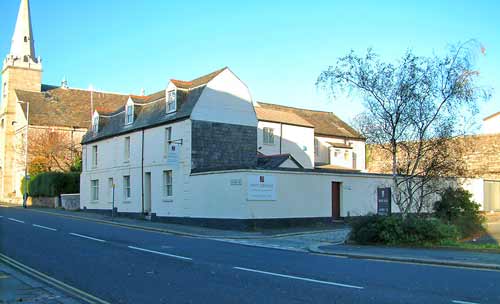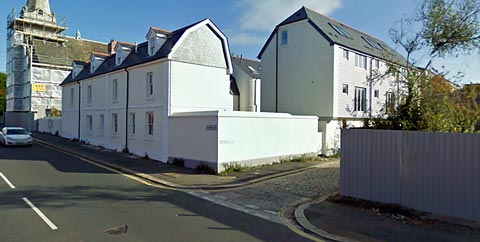The Manor Office
The Manor Office (sometimes referred to locally as the Manor House) is believed
to have been built c1797; although postally and historically designated 9-14 Chapel
Street, it's current address since redevelopment is
Barrack St (being the name of the cobbled lane to the side).

Above: The Manor Office viewed from Chapel Street 2003
Below: The same view at 2009 (courtesy Google)

This building was orginally the offices of Stoke Damerel's/Devonport's Lord of the Manor, where rents were paid and business
in the town taken care of, hence the name Manor Office. In 2001 the property was sold by The Right Honourable John
Francis Arthur, Baron St Levan; this is also when the last tenant under the St Levan
ownership, Atkey Goodman & Co, moved out.
1896 - Birthplace of Ralph Alger Bagnold
Ralph Bagnold was born in the Manor House on 3rd April 1896. In adult life he carried
out pioneering physics research on the movement of sand, in rivers, in oceans and in
the desert. He wrote several books on the subject and much of his published work
is standard reference material for researchers. The example is often given that
his book,
The Physics of Blown Sands and Desert Dunes, was used by NASA in their
design of the Lunar Land Rover, and in their exploration of Mars. [1]
Bagnall led a distinguished life and followed two careers, as a soldier and as a scientist.
He won many awards during his life, including
the Gold Medal
of the Royal Geographical Society in 1934, Fellow of the Royal Society in 1944, the G.K. Warren Prize by the U.S. Academy
of Sciences in 1969, the Penrose Medal by the Geological Society of America in 1970,
the Wollaston Medal from the Geological Society of London in 1971, the Fellowship
of the Imperial College in 1971, an honorary D.Sc. by the University of East Anglia
in 1972, the Sorby Medal from the International Association of Sedimentologists
in 1978, an honorary D.Sc. by the Danish University of Aarhus in 1978, and the David
Linton Award from the British Geomorphological Research Group in 1981. See [1] for fuller information and a photo of Ralph Bagnall.
1975 - Listed Status
On 1st May 1975 the Manor Office was listed as Grade II by English Heritage - Building ID 473234. It
is described as ... "a 3 storey large house with two attached houses to an overall L
shape. The exterior is rendered and painted brick with some slatehangings to the
return; the attached houses having mansard roof with 3 gabled roof dormers. Some
of the original sash windows are restored and there are some later C19 sashes and
C20 windows. The interor has panelled dado, panelled doors and a dentilled cornice to one of the ground floor
rooms, and the staircase has plain balusters and column newels..."
For further information and a fuller description the property is detailed
on the
English Heritage website.
2003 - Application for Change of Use
On 16th July 2003 the new owners of the property submitted planning application
number 03/01197/FUL to convert the building, the address given as 14 Chapel Street,
PL1 4DP, "from offices to 5 dwellings, and erection of 3 three storey dwellings
(with integral garages)". The owner at this time being Grenco Lodge Ltd, The Old
Stables, Annery Monkleigh, Bideford. The architects of the submitted plans were
Moxley McDonald Architects Ltd, Chapel House, South Brent, Devon TQ10 9BH.
Reconstruction took place during 2005-2007. When completed the new properties were marketed as Manor House Mews; the courtyard
style of the development certainly lent itself to such a name. The address of the Manor House complex was no longer Chapel Street, henceforth
it came under Barrack Street. (This site has a separate page for details of
Barrack Street and property prices etc.)
Following are some images of the 16 homes within the redeveloped Manor House, courtesy
of
Zoopla. The images are
in no particular house-number order, they're to give you a feel for the layout, style, decor and
general character of the redevelopment.
Mews-type Exterior
.jpg)
.jpg)
.jpg)
.jpg)
.jpg)
.jpg)
Kitchen Styles
.jpg)
.jpg)
.jpg)
Staircases
.jpg)
.jpg)
.jpg)
.jpg)
.jpg)
A Bathroom
.jpg)
View North, towards St Aubyn Church
.jpg)
.jpg)
.jpg)
Reference:
[1]
www.geolsoc.org.uk
(page added 1st March 2012)